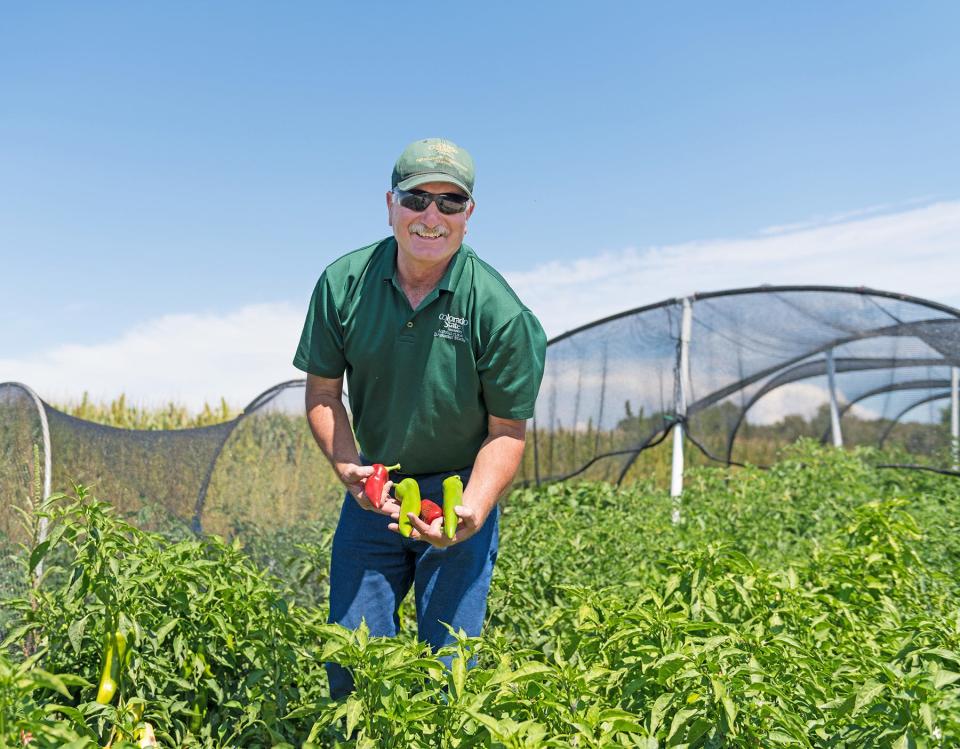On a hot streak: Retiring Pueblo pepper propagator plans to continue chile culture
When Mike Bartolo inherited a bag of chile seeds from his late uncle, a St. Charles Mesa farmer, little did he know he was embarking on a years-long journey that intertwined agriculture with heritage and linked the Pueblo chile’s past to the future.
“It has nothing to do with skill, but luck, it was all by happenstance,” Bartolo, 59, admitted as he prepares to retire Dec. 31 from the Colorado State University Arkansas Valley Research Center in Rocky Ford. “My uncle, Harry Mosco grew up on the St. Charles Mesa and farmed right next door to my parents.”
When Mosco died, Bartolo’s aunt, Helen Mosco, gave the seeds to him.
“From that original bag of chile seed I started selecting different varieties. Out of the strains I inherited from my uncle came this other variety, it's pretty unique from that original strain - because it’s a little longer and thicker-meated,” he explained.
During the past quarter-century, that strain, which he named the Mosco, in honor of his uncle, is today, “the predominant form of Pueblo chile,” he said. “Most all the farmers are growing it now,” he said.
The chile is fairly hot measuring 5,000 Scoville Heat Units which makes it hotter than the Hatch, New Mexico peppers, he said.
Story continues below

Pueblo chile's rich history goes back generations
When Bartolo began his journey with the Pueblo Chile, chile seed already had grown in the area since the early 1900s. There are a number of Italian families that had been growing peppers from seeds they saved, so all the Pueblo chiles grown in the area were generally the same, but each family had slightly different strains.
"The Pueblo Mira Sol chile was very common for all those families, including my own, the Moscos, DiTomasos, the Mussos and many others,” Bartolo explained. “It could have been generations that seed was in the family.”
“That’s why I am excited about chile seed — it is not just a product — it is part of your culture and your heritage,” he said. “Pueblo chile is so important to Pueblo as it really is weaved into cultural tapestries and is part of so many good memories of food and family."
The prolific peppery pinnacle of Bartolo's career came this year when “I made over 500 selections of chile,” he said. “It was not on my radar screen, but it was something I became more and more interested in."
Free tuition: CSU Pueblo to offer first-time students with family incomes of less than $50k free tuition
Today Pueblo Chiles appear in local products like Walter’s beer, Jojo’s Sriracha and Springside Cheese. They also are used at many local restaurants for everything from sloppers (an open-faced green chile slathered cheeseburger) to pasta dishes and even chocolate.
“To me, it validates all the hard work and sacrifices my grandparents and great grandparents made. They lifted the load and took the risk and now all their hard work has come to fruition and that makes me happy,” Bartolo said.
“I hope we maintain that heritage. We don’t want to lose that connection,” Bartolo said of Pueblo’s chile farming.
Story continues below
From the classroom to the field
Having worked for the university for 31 years in Rocky Ford and a couple of years in Fort Collins before that, Bartolo has put his degrees to the test. He holds a bachelor's degree in bio-ag sciences, a master's in horticulture and a doctorate degree in plant physiology.
Still, he said, the best information he learned came from farmers.
“The science part is some of it, but we underestimate how inventive and innovative farmers are. I learned so much by being quiet and listening to them,” he said.
His work with the Arkansas Valley Research Center has extended far beyond chile into the arenas of Rocky Ford’s famous cantaloupe and watermelon crops. Part of that work was to introduce drip irrigation practices to reduce water usage.
As the drip irrigation practice is applied to melon crops, farmers are “helping preserve that natural resource,” he said.
The future of Colorado's agriculture
It hasn’t all been easy. Bartolo has watched agriculture change dramatically.
“Seeing land conversions, water sales, some of the economic struggles, it has been tough. I am a little nervous about the future of ag — I fear losing our connection and destroying our natural-resource base,” he explained.
As he watches houses being built on “the most productive farmland,” on the Mesa, he fears a sprawling city will someday replace the green farms.
"I think it is going to be a tragedy if our grandkids and great-grandkids look back and say ‘What did you do — you had the garden of Eden and you annihilated it, exterminated it, for nothing but greed and ignorance.’ Then the only place they can see it is to go to the El Pueblo Museum to see what a Pueblo Chile looks like,” he said.
Although he is retiring, Bartolo said he will continue to advocate for agriculture through the Colorado Fruit and Vegetable Growers Association and the Pueblo Food Project. He will continue to cultivate his small Rocky Ford farm and work on chile pepper propagation.
“When the seed catalogs come out in spring, I will get itchy to do some planting and get dirty,” he said with a laugh.
Trending: 1 person dead after weekend stabbing in Pueblo
Chieftain reporter Tracy Harmon covers business news. She can be reached by email at tharmon@chieftain.com or via Twitter at twitter.com/tracywumps.
This article originally appeared on The Pueblo Chieftain: Retiring Pueblo chile pepper scientist to remain an ag advocate

